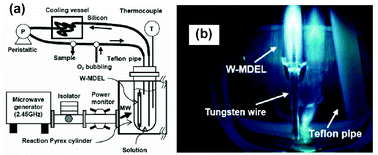Exposure to low doses of the xenoestrogen bisphenol A (BPA) and to the hormonal 2,4-dichlorophenoxyacetic acid (2,4-D) herbicide, an environmental endocrine disruptor, can have serious health consequences such as the induction of mammary gland ductal hyperplasias and carcinoma (LaChapelle et al., Reprod. Toxicol., 2007, 23, 20; Murray et al., Reprod. Toxicol., 2007, 23, 383). To the extent that these toxins are present in wastewaters (Donald et al., Sci. Total Environ. 1999, 231, 173; Brotons et al., Environ. Health Perspect. 1994, 103, 608; Oleaet al., Environ. Health Perspect. 1996, 104, 298; Biles et al., J. Agric. Food Chem. 1997, 45, 3541; Markey et al., J. Steroid Biochem. Mol. Biol., 2003, 83, 235), we examined their oxidative destruction in aqueous media by a novel light source. A tungsten-triggered microwave discharge electrodeless lamp (W-MDEL) was fabricated for possible use in wastewater treatment using vacuum UV-transparent quartz in which a tungsten trigger, also embedded in quartz, was attached to the MDEL to aid in the self-ignition of the lamp on irradiation at low microwave power levels. The quantity of mercury gas in the W-MDEL was optimized by monitoring the continuous radiation and peak intensities of the emitted light in the vacuum UV (VUV) and UVC regions. The usefulness of the W-MDEL device was assessed through the degradation of 2,4-D and BPA in air-equilibrated aqueous media and in oxygen-saturated aqueous media. Enhanced degradation of these two xenoestrogenic toxins was achieved by increasing the number of W-MDEL devices while keeping constant the microwave radiation feeding each W-MDEL lamp. This novel lamp provides an additional light source in the photooxidation of environmental contaminants without the need for a metal-oxide photocatalyst. Under our conditions, process dynamics using the W-MDEL light source are greater than with the more conventional photochemical methods that employ low-pressure Hg arc electrode lamps in synthetic quartz to degrade these two toxic contaminants.


 Please wait while we load your content...
Please wait while we load your content...